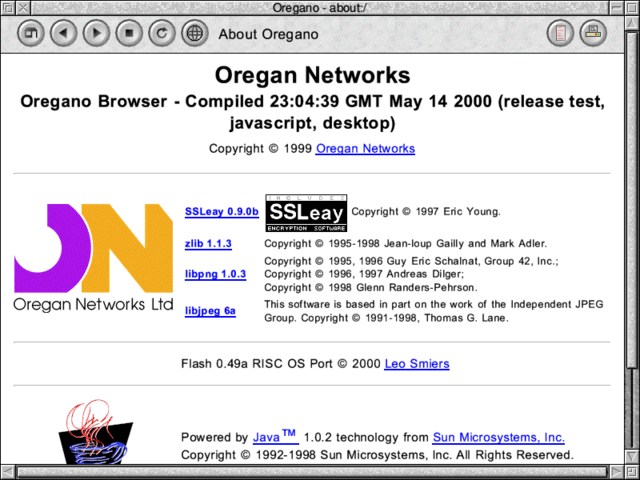Oregano browser review (2000)
A review written for Acorn User magazine
Acorn User was a proper magazine, so I could go in to WH Smiths in town and show my parents an article with my byline on it. I generally got involved with networking articles and was the games editor for a while.
I've recreated this article from the original (unedited) word processing document. Images are the originals, placed according to instructions in an accompanying email. It's quite something to read about the state of the art in web browser technology in 2000, and see screenshots of Amazon back when it only had six departments!
I won't insult your intelligence by waxing lyrical on the importance of the internet in modern society; suffice it to say, any modern computing platform needs to be able to hold it's own with regard to accessing this global communications network. And RISC OS has not been without it's contenders, with web browsers such as ArcWeb, Webster/Webster XL, Webite, Browse, and Fresco springing immediately to mind. However, as time passes all but one seem to have fallen by the wayside as far as updates are concerned, and everyone bemoans the fact that we just aren't keeping up with the likes of Netscape and Internet Explorer.
Enter the new kid on the block, Oregano. Perhaps "new" is a little misleading as it's been worked on for the past couple of years, but for the NC (network computer) market; however, it was not without a little frisson of excitement that I opened my email to find a freshly compiled copy of the new desktop version, complete with beta status warnings, waiting for me to play with. After a brief flurry of activity on the newsgroups following the announcement of it's impending release, this was already on my must-see list for the Wakefield show.
First impressions...
The NC heritage is apparent right from the start; the dark toolbar and strange habit of displaying the "throbber" (the obligatory spinning globe that tells you when a page is being fetched) down in the bottom right of the browser window had NC written all over it. And where was the URL bar? there was no obvious means of typing in a web address, kind of a minus point for a web browser. A little investigation and it turns out that the current URL is displayed in the window's title bar, the page title in a space between the left and right hand icon groups, and you have to select one of the icons to replace the page title with an area to enter a URL. I wasn't expecting a learning curve with a web browser, but after a while it did seem that what at first seemed to be a hindrance could prove to be one of this browser's plus points; the minimalist toolbar leaves maximum browsing space, especially once you discover the Dynamic toolbar option which hides the toolbar until you move the mouse pointer up to the top of the window; it even slides up and down à la the Windows taskbar for added cool points. It just goes to show a little patience goes a long way.
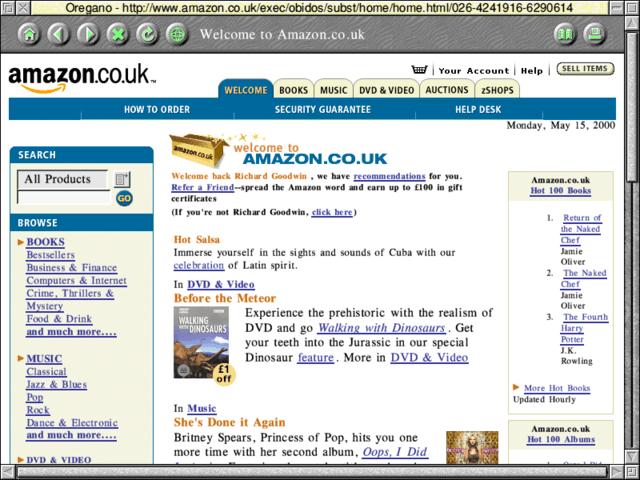
As for the dark tools and windows, this should be taken care of via a little skinning - the current vogue for changing the look of a program by changing it's icons and background images. Initially disappointed to find that this didn't work on my beta copy, I poked around inside the application's directory and found that by augmenting the default skin with a few files from some half-finished examples I soon had a passable fake of the Ant Suite version of Fresco and Acorn's Browse.
...And we're off!
So, after a few false starts and few visits to the choices window to switch on things like JavaScipt I'm ready to browse in earnest. I know what most people will be asking at this point - is it stable, and is it as fast as they say? And I have to answer right away yes, and oh yeah baby! Over my aging modem at home it was hard to tell the difference between Oregano and close rival Fresco, except of course with the newer browser there was none of Fresco's annoying habit of appearing to hang the machine while waiting for those last few images to download. To get a proper comparison I just had to take them in to work and spend much of the day web surfing over the company's leased line. Not only did Oregano load pages from machines on the local network pretty much instantaneously on my StrongARM machine (compared with Fresco's pedestrian performance even trying to load pages from cache), I can honestly say that it didn't crash once while I was browsing - when I was fiddling with unfinished options, yes, but never when browsing. Your mileage may vary of course, some people have no problems with Fresco, but this stability even in a beta version was quite refreshing.
Straight web browsing is all well and good, but there are only so many times you can read the Slashdot site in any one day; it was time to start putting Oregano through it's paces. Another area where RISC OS is perceived to lag behind is that of e-commerce, which combines slightly newer technologies such as SSL (Secure Sockets Layer for encrypted data transmission), cookies (for remembering your details) and perhaps even a little JavaScript. Although Webster XL, Browse and Fresco have recently been updated to handle some or all of these functions, support can be a little patchy and quite a few people who have the option admit to using a PC browser for online shopping, myself included - it's real money at stake after all. I did a quick tour of the usual stomping grounds - Amazon.co.uk, e-Bay etc. - without incident but finally decided on a rather nastier test for the newcomer, a German site specialising in domain name registration that's only accessible using SSL right from the first page. To cut a long story short, again it passed with flying colours - not only did the SSL module not stutter once (I've found some browsers to need a retry on every third or fourth page fetched), but it handled the small toolbar-less JavaScript popup window perfectly. It didn't allow for the Internet Explorer trick of pushing the data back into the main window from this popup, but I did find that I could cut and paste between writable icons which achieved the same ends.
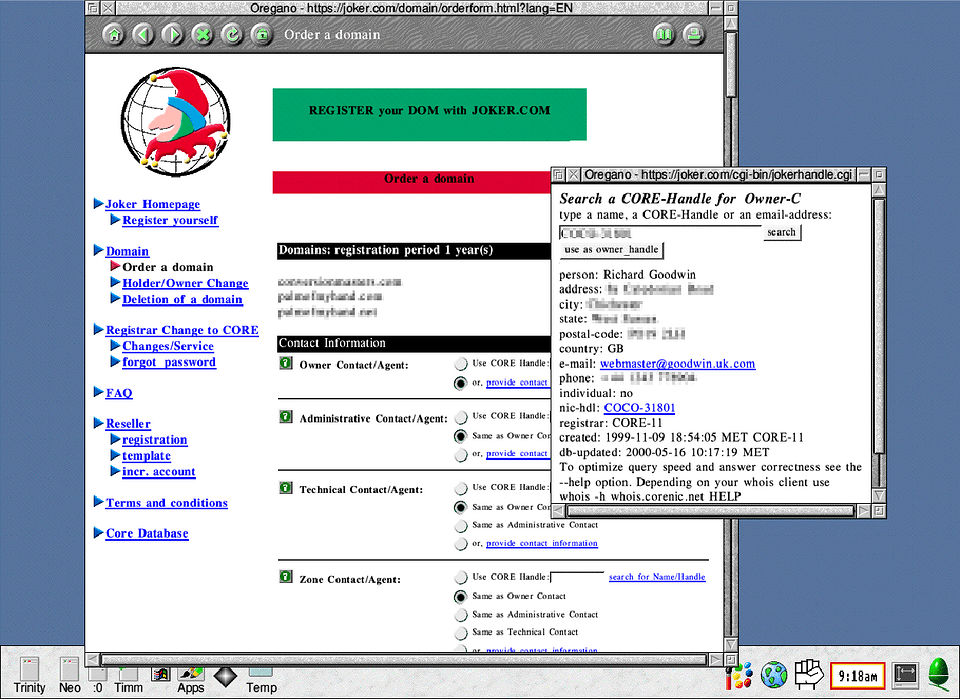
The JavaScript implementation seems to be a particularly good one; simply not seeing errors when there might not be any error reporting option is one thing, but as a real test I tried it on a professional loan calculating site that Fresco is known to mess up on and it sailed through. One of the really nice touches is that if you get any problems with a site complaining about you not using Netscape or Internet Explorer then you can just select a faking option from a menu and hit the reload button - no need to quit the browser or use third-party hacks, it resets both the identity sent to the web server and the JavaScript ID straight off. Rollovers are handled well too; this is where an image changes when you move the mouse pointer over it. Fresco doesn't blank the background when changing states, so with images that have transparencies in them you get leftovers from the previous image - not so Oregano.
Room for improvement?
This is not to say everything is spot on with Oregano, there are some things I would like to see changed which can't be put down to being a beta version of the software given that it's basically a previously developed NC browser with a new desktop front end.
Table rendering is a black art at the best of times, and in some ways Oregano's better than other browsers; it managed to render Amazon.co.uk where Fresco renders the site twice as wide as the current browser window, no matter what size the window is. There were none of the padding and alignment glitches as with Webster XL. It even beat Internet Explorer 5 on some pages. On a few pages though it seemed to get the widths of columns wrong, which is not exactly a new experience but manifests in some odd places. It does however allow for images in the background of table cells, a first for RISC OS I believe; it doesn't do textures across an entire table or row, but I think this is per the HTML spec.
The True Type font rendering is in place, but this seems to be a replacement for the standard RISC OS fonts rather than augmenting them. This system is good enough - it antialiases at least - but doesn't add the <font face...> command so far has only been implemented in Webster XL under RISC OS, and the spacing/ leading seems a wee bit out to my eye. I copied over the Arial font files from my Windows 98 PC at work, renamed them, edited the browser's options and had everything rendering in the sans serif font straight away, no conversion, no fuss, which is a good test of adhering to standards, but I'd have liked to have seen multiple fonts on the same page, a must for that next big step towards cascading style sheets. Also many named character entities came out as little boxes - I don't know if this was a problem with mapping between PC and RISC OS fonts, but it should at least be able to render a hard space properly. Plus unordered lists being done in the ArcWeb-esque coloured balls is cute on a standard black-on-white website but looks odd on a black background, and doesn't allow for things like square bullet points - the standard way is to use a symbol-style font to render bullets.
Image handling is fast and accurate. However, the trade-off is there's little dithering in 256 colour modes, and the display broke up altogether in a 16 colour desktop with text spewing across the bottom of the screen, so I quickly made sure I was using at least 32 thousand colours in the desktop when browsing. Given this and the use of dynamic memory areas only found in RISC OS 3.5 and above it limits the target audience to users of RISC PCs, A7000s and the newer non-Acorn hardware. I guess there comes a point when developers have to stop supporting what is now perceived as obsolete hardware and just work with more current machines - a harsh truth but perhaps a necessary one these days, if a little ironic given that it's the older machines that could benefit most from such a speed boost. Other graphical quirks are that it doesn't support <img... width="100%"> required for using images as full-width ruler bars or pull off some of the fancier border effects, the lack of support for BMP (okay, RISC OS browsers generally don't, but it's common in PC land) or Acorn Sprite (used in some RISC OS only help manuals), and PNG support has only one level of transparency as opposed to the full 256 levels - I've only ever seen this pulled off properly in Acorn's Browse, even PC browsers don't do the full spec on PNG, but it would have been nice.
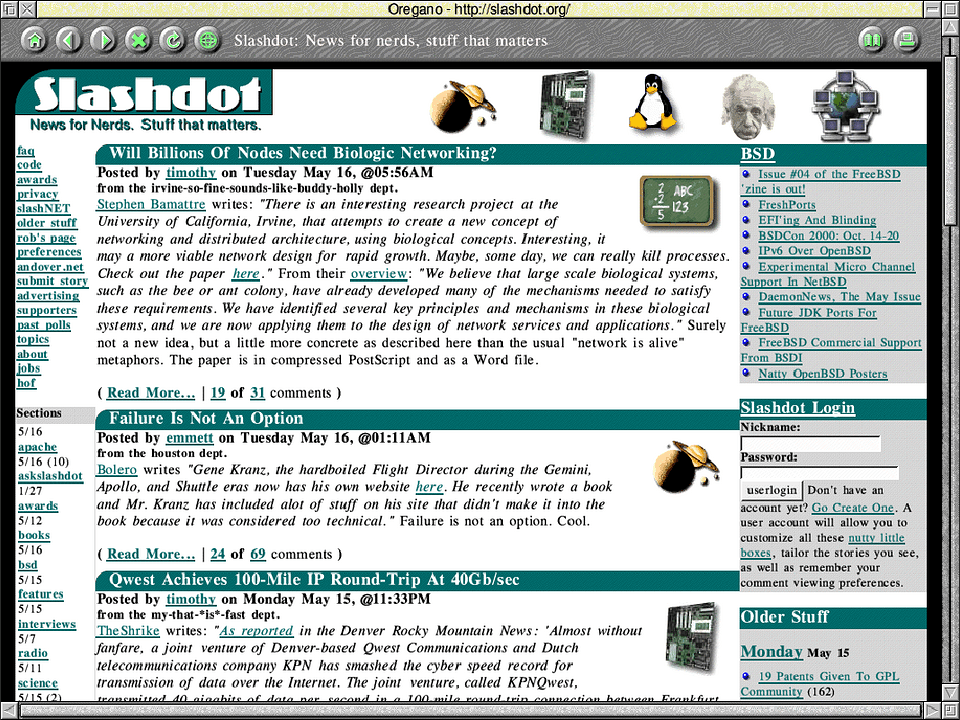
This browser is just too good to end on criticisms though; it does handle even complex pages well. Browse never quite made it to the stage where it could handle text flowing around images and inline tables, but Oregano handles these at least as well as Fresco and with better spacing than Webster XL. It also handles plugins, even adding the details of things like Java and the recent Flash conversion on the fly to the ubiquitous About: page if they're installed. Although Java loaded on request it didn't appear to kick in properly even with Java applets that Fresco et al could handle, perhaps a minor pre-release hiccup given that my copy of the browser came with Oregan's website set as the home page and, as they have a Flash intro on their site, the first page I saw using Oregano was a full-on Flash movie. Nice.
I couldn't resist a final poke around in the guts of the program to see what options were available, and try to figure out how to create skins; I managed to create something that gives a pretty fair emulation of the new Apple "Aqua" style desktop to go with the desktop theme I'm working on, even down to being able to colour the drop shadow around text entry boxes a nice shade of blue. This is possible because the program implements it's own writable icons rather than using the ones built into RISC OS, which will no doubt infuriate the purists and can lead to some slightly odd handling, but looks cool. The whole system is extremely configurable (although the actual controls weren't finished in my version, I had fun with the raw text files), so I dearly hope that Oregan/Castle will release the full documentation for this system so that others can play too; it can only increase the popularity (and by extension, sales) of the browser if websites start popping up devoted to Oregano skins, especially if some bright spark writes a converter for Netscape 6 or NeoPlanet skins.
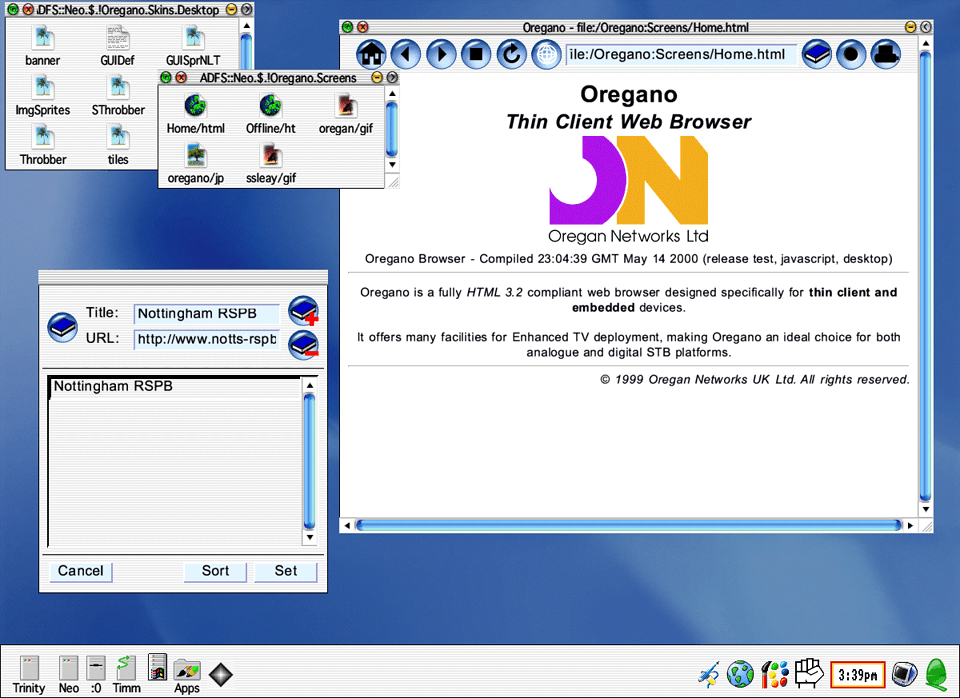
Final words
So what does all of this mean to those of you looking to replace your current browser with something a bit better, or looking to jump in for the first time? What it doesn't bring to the party is anything astoundingly new; no cascading style sheets or extended graphical abilities, the True Type support seems to be there just to replace perfectly good RISC OS fonts and not augment them with <font face...> support, and it's not quite up to spec on a few minor things including the RISC OS style guide. What it does do is handle the things it can do extremely well - the stability and speed of browsing surpasses anything that we've had to put up with so far, and JavaScript support seems to be the best yet on this platform. It's NC heritage not only brings something fresh to your desktop (such as being able to navigate pages properly using just the keyboard, oriental language support and so on), it should also ensure future development. Very minor niggles aside, this could be exactly what the RISC OS community has been waiting for, and it's such a joy to use it's already replaced one or two of the icons pinned to my backdrop - I can't give it more praise than that.
Bonus images
All of the images that were taken for the review; only a few were included in the text:



